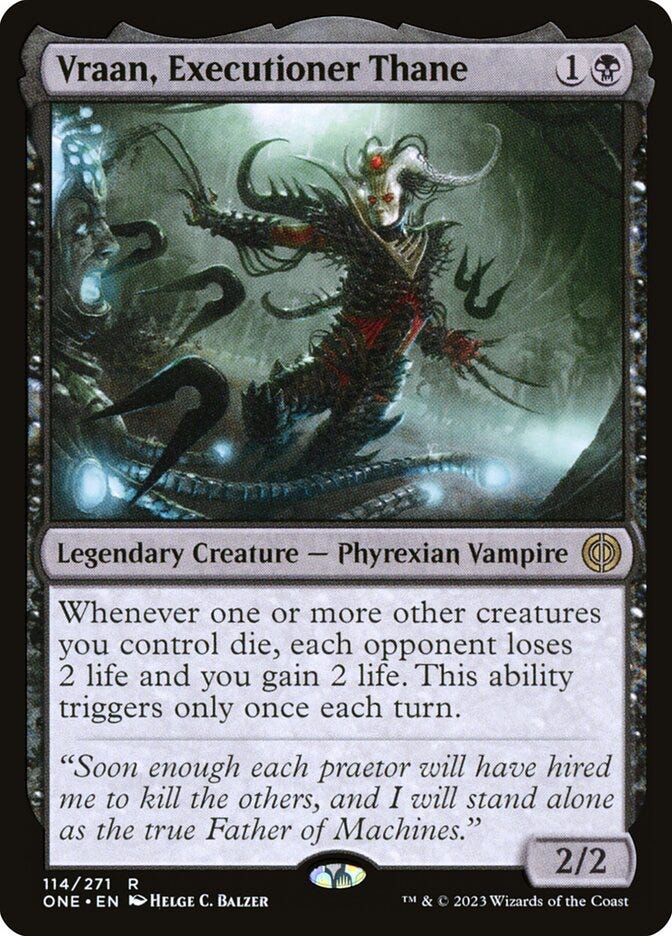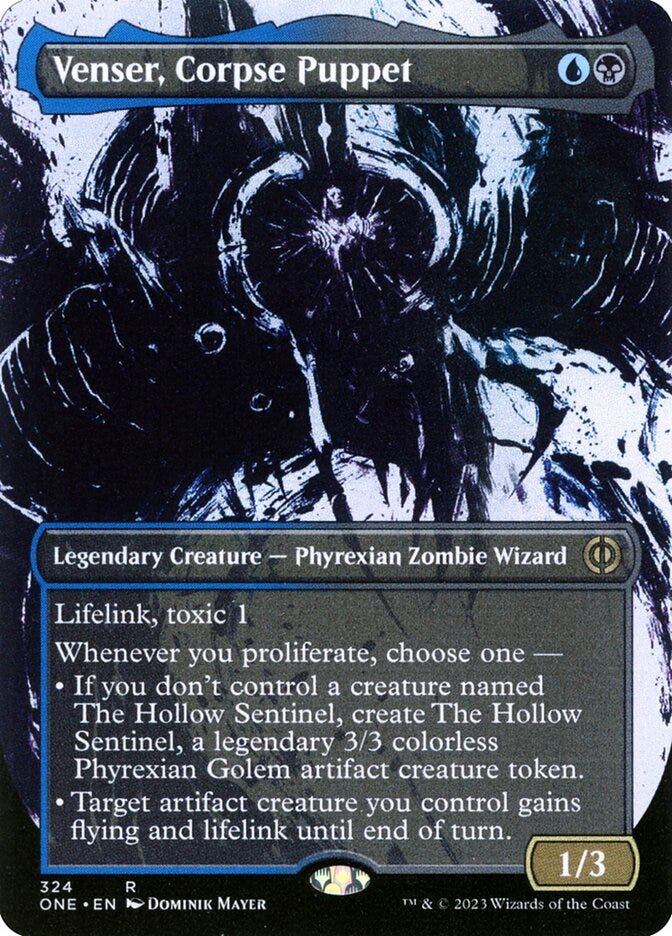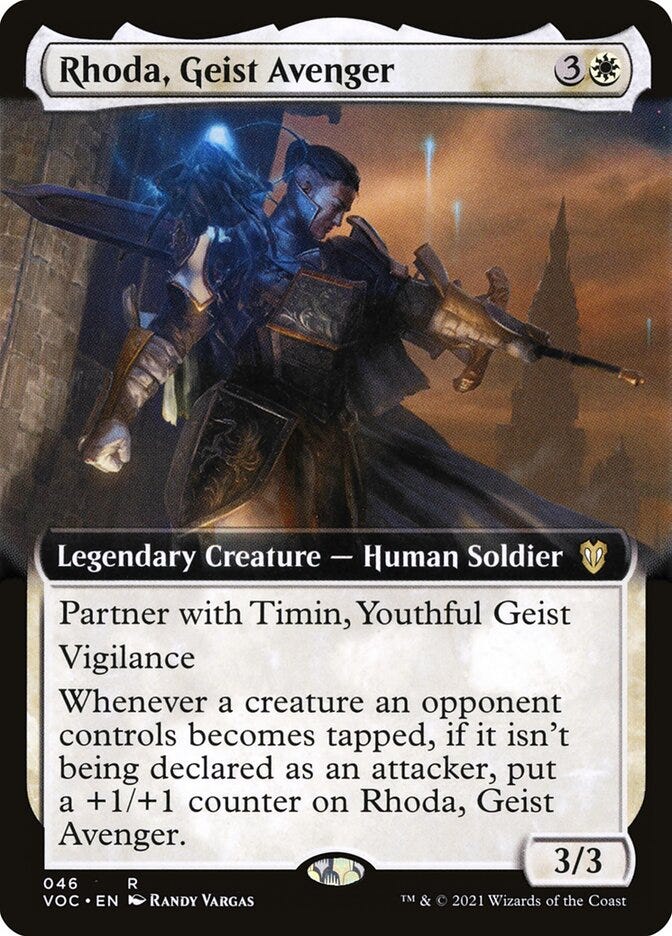Defining Terms
I’m all about putting pen to paper on ideas that I use when playing or deckbuilding (if you’ll allow me some self-promoting on my own platform, check out my article about chance or my article about parity), and the ideas of Inevitability and Lethality are ones that I use both when deckbuildings and when doing threat assessment. Let’s define our terms:
Inevitability
/noun/
: [of an EDH deck or card] the trait of being able to consistently apply damage and progress towards a win condition
Basically “persistently dealing damage to inevitably win.”
Lethality
/noun/
: [of an EDH deck or card] the trait of each instance of damage being of high relevance towards approaching a win condition
Basically “each instance of damage being a big step towards approaching lethal.”
Note: In these definitions, I’m using “damage” to refer to anything that progresses one or more opponents towards dying. Not just talking about literal damage.
Note 2: For the sake of this sermon, I’ll consider a huge burst of damage to be one “instance” even if it technically comes from multiple sources (e.g. a Grapeshot with plentiful copies).
Lethality
Lethal
/adjective/
: of, relating to, or causing death
: very potent or effective
(definitions provided by mirriam-webster)
Lethality is a measure of how deadly each instance of damage is to your opponent. You don’t have to try to deal damage a bunch of times if dealing damage a handful of times is sufficient. There are two major ways damage can be more lethal: being irreversible or being done in bigger bursts. Let’s talk about some examples.
Voltron
Commander damage is the most common type of irreversible damage. It doesn’t matter if you’re running an original elder dragon, the poster-child of voltron, everyone’s favorite glutton… or just a 2/2 that you attack with sometimes. If your commander deals damage, that damage cannot be undone. It can’t be healed or removed. No matter how many times they double their life total, they will not shake off the commander damage that you’ve dealt to them.
Cards that Chunk
There are plenty of ways to deal large bursts with individual cards such as a Rakdos Charm or Deadly Tempest (on a board where your opponents have too many creatures). While aristocrats decks are more well known for death-by-100 cuts, cards that regularly produce a ton of life loss at once, such as The Meathook Massacre or Vicious Shadows could be considered an example of a high burst of life.
Combo
We all know how I feel about combos by now, but it’s undeniable that combo wins are fairly popular and worth mentioning. Winning with a combo would be an example of a high-burst wincon. You don’t have to combo Exquisite Blood and Sanguine Bond together several times to win the game… one time is enough.
Phage the Untouchable
This is Phage the Untouchable. She belongs here.
Poison
Poison is the poster-child of irreversible damage, often bemoaned by newer players for being incurable (as in, unable to be healed from). Like voltron, each damage of poison is unable to be redacted, but since infect decks most only deal 10 damage to kill a player, each poison damage is approximately equal to 2.1 commander damage. Infect itself is also a great example of burst-based-lethality because the way that damage boost interacts with pump spells (a la Giant Growth) leads to many infect-based poison strategies to 1-hit-K.O. a player.. Poison is also a little more flexible in application, being able to be applied by more than just your commander, and proliferated at instant speed. Despite poison as a strategy being mostly underpowered (and more well known for a few problematic cards that buff a deck’s lethality without it being a poison deck), it’s no wonder that poison is notorious for being a very lethal deck type.
Inevitability
Inevitable
/adjective/
: incapable of being avoided or evaded
(definitions provided by mirriam-webster)
Inevitability is a measure of how often and persistently you can continue to apply damage or progression towards your win condition. It doesn’t matter if each piece of damage you do isn’t that impactful if you can constantly, consistently, and incessantly deal damage towards your opponents. The major ways threats become more inevitable are by being durable or by being unavoidable.
Protection
One obvious way threats become more durable is simply by being protected. Thrun, the Last Troll is a prime example of self-protection (hexproof AND regenerate significantly limits the number of options people have for actually dealing with the growing threat). Indestructibility, ward, or even self-flickering (like Ætherling) can help threats protect themselves. A deck, overall, can also supplement a wincon that doesn’t protect itself with cards like Heroic Intervention.
Tax Evasion
In a game of commander, when your commander gets removed or exiled you can cast it again for an additional cost of two generic mana. This means if people consistently try to answer your commander then… over time, your commander gets further and further away from being accessible. There are, however, commanders that don’t pay their taxes. Yuriko, for example, has an ability that allows you to get her into play for just two mana without paying pesky commander tax, meaning you can persistently get her trigger throughout the game no matter how many times she’s died. Similar effects, such as Derevi's, can make a commander-based threat very durable.
Recursion
Another way that threats become more durable is if you can consistently bring the back from death (similar to the above tax evasion category, but for more than just your commander). Spells that return win-cons and threats from the graveyard, such as Animate Dead or Phyrexian Reclamation (or Praetor’s Counsel, Eternal Witness or Archaeomancer) make a deck more durable overall in presenting its win.
Evasion
Evasion in general helps make threats deal damage that is less avoidable. Whether you’re using something like Tesuko Umezawa to make other creatures unblockable, or simply attacking with a 59¢ dragon that happens to have flying, the ability to get in for damage more consistently and more often is the cornerstone of being more unavoidable.
Slow Drain
I’d say aristocrats is the embodiment of unavoidable damage. You may take only a couple damage here or a couple of life loss there, but there are very few ways to prevent yourself from taking life loss, making it hard to avoid the damage as it’s being dealt out. Liesa, Shroud of Dusk is a paragon of inevitability, she exemplifies unavoidable damage since people have to cast spells (and therefor will take damage over time), but she also commits tax fraud just like Al Capone.
Card Advantage and Interaction
I’ll just slide this footnote in. Although individual cards don’t themselves become more inevitable by drawing cards, decks certainly do. If you play more card advantage in your decks, your decks will recover from more board states… and if you play more interaction, your deck will survive more otherwise lethal events. Threats that pride themselves on being durable and unavoidable often need the time and engine that card advantage and interaction provide to stay alive long enough to finish the job. Notably, however, these need to be paired with things that are actually causing your opponents to become nearer to their deaths.
My Decks
So I’ve tried to pull out some examples of lethality and inevitability, but I’m not recommending you go out of your way to play some or any of the commanders or wincons I’ve mentioned here. More… the question is to apply these ideas to your decks (or prospective decks) to ask yourself if the deck is actually progressing towards a win, and if it’s using inevitability, lethality, or both. So, here I’ll list some of my active decks and explain how the concepts apply (click on card images for deck links).
I would describe Vraan as high inevitability but with low lethality. The deck does damage over time from aristocrats drain and tries to utilize superior card draw and some amount of removal to out-last opponents. Very rarely does it do a huge chunk of damage. Often, this deck gets to take advantage of its low lethality (because Vraan is “just a little guy” and there’s usually something more lethal hanging out at the table for people to target).
Venser has high lethality and high inevitability. This deck built to, rather than burst people down as some poison decks do, use some amount of control and card advantage with proliferate effects to take the game slowly and persistently… one irreversible damage at a time.
Rhoda (paired with Timin, of course), also has a mix of lethality and inevitability. Like Venser, this azorious pair functions as a control deck that taps things down to increase voltron damage. Commander damage gets lethality from being irreversible. Because it’s a control deck with plenty of card draw and interaction, and it also runs plenty of ways to make its damage unblockable (such as Spirit Mantle), it gets a decent amount of inevitability. Finally, since Rhoda can do a huge chunk of burst damage by casting a Sleep when an opponent has a huge board, that also increases the lethality as well.
Threat Assessment
When assessing what threats to hit with a humble removal spell, usually players will ask the question “what threat is going to kill me right now (or very close to right now)?” This is a question of the lethality of the threats on board. But when no threats are on board, a similar thing can happen when assigning targets - one must question the lethality of the decks and players at the table.
While it’s well known that an inevitable threat, especially one just as powerful as a lethal threat, must be killed before they reach the point of no return… usually the more lethal threat takes priority. Even when nothing is deployed on board, people will place more aggro towards the decks and players with higher lethality.
For example, a deck that hopes to assemble a combo that can kill people from full HP to 0 HP in one turn tends to receive more aggro and interruption than a deck that hopes to do between 2 and 8 damage a turn, and win over several turns.
In 1978 five researchers (Sarah Lichtenstein, Paul Slovic, Baruch Fischhoff, Mark Layman, and Barbara Combs) did a series of tests with 660 adult subjects. The conclusion was that subjects systemically overestimated the frequency of deaths that were dramatic and systemically underestimated the frequency of deaths that were not.
There are lots of biases that affect how people judge risks. The availability heuristic or optimism bias, for example. But another such tendency… the tendency that leads us to overestimate the risk of something sudden, violent, dramatic, and out of our control (such as being bitten by a shark) and underestimate the risk of something gradual, calm, casual, and under our control (such as smoking) is one that draws me back to what I said about my Vraan deck’s “high inevitability and low lethality.” If someone’s presenting a slow bleed: it’s gradual, each instance of a damage isn’t that big of a deal, and we can Path to Exile the commander any time we want (we’re in control, we’re not not addicted, we swear, we can quit at any time)! By comparison, if someone has a combo lurking in their deck that will win out of nowhere, any top deck could be a sudden game over.
It’s not quite the illusion of control, because the player with the Path actually CAN use it at any time. But more often than not, they won’t deal with it until it’s too late… because “2 more damage isn’t that big of a deal, and what if something even scarier happens!”
This quirk in threat assessment is something that we could intentionally take advantage of (after all, I’d argue that if you want to win… you want to be the 2nd most powerful player while the 1st most powerful player is in the archenemy seat), sure, but it’s also something that might encourage us to keep more of a close eye on the player presenting something that’s inevitable.
Conclusion
Ultimately when threat assessing, you’re constantly between a rock, a hard place, and an even harder place. But the push and pull of the game is what makes it a fun one to play. Really, the most important thing when considering these ideas is to remember that your decks MUST have a wincon… and if your wincon isn’t lethal or inevitable, it probably isn’t going to be winning very often.
Enjoy a daily koan:
The coin that’s lost in the river is found in the river.
Repeat that one to yourself ten few times. Then consider it while sitting under a tree. Rinse and repeat.






